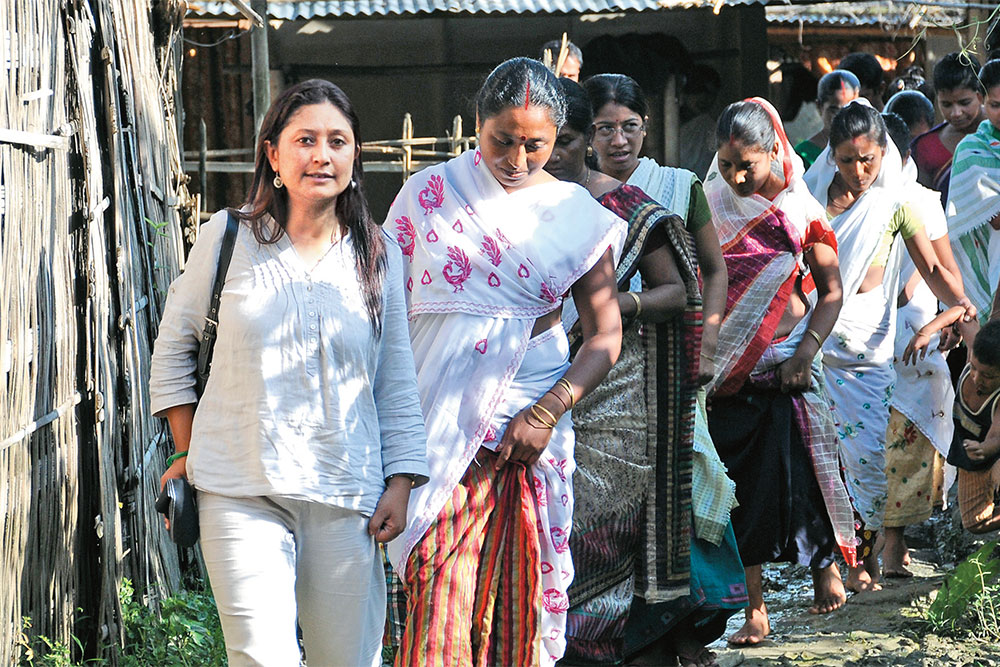It takes us just under seven hours to cover the 250-odd-km rocky, hilly, busy route between Shillong, Meghalaya and Panbari village in Golaghat district, Assam. At the end of the backbreaking journey lies the home of master artisan Rekha Doley, not very far from the tourist-friendly Kaziranga National Park. Doley’s home is a picture of idyllic rural life, complete with a set of excited farm animals, a changhar or stilt house common in inundated Assamese villages and a khal or lion loom — so called for the teeth that draw the yarn in — occupying pride of place on the porch of the thatched mud and bamboo structure. Doley, who used the loom to stitch her own and her family’s clothes for years, now uses it to make multi-purpose scarves and other fabrics for the Shillong-based Impulse Social Enterprises (ISE), thereby supplementing her husband’s schoolteacher income and supporting a family of 11. “It wasn’t possible for me to travel for work, so I’m happy I can earn at home thanks to Impulse. I love learning new patterns and travelling with other weavers for training to the city,” she smiles.
Started by Shillong resident Hasina Kharbhih (43) in December 2010 with an initial investment of ₹10 lakh, ISE works to prevent unsafe migration and human trafficking by providing communities in northeast India a livelihood in their own neighbourhood. The Fulbright scholar and Ashoka and Aspen fellow first started the Impulse NGO Network fresh out of high school in the early 1990s to market Meghalaya’s rich tribal handicrafts. Beginning with her ancestral village of Syntein in the east Khasi hills, in the middle of the now-famous Mawsymram district, Kharbhih started searching for ways to push consumption beyond the weak local demand. She began marketing the prototypical textile, bamboo, cane and silk articles made by her network of artisans through her eldest brother’s fruit and spice export firm Sen Kharbhih, dealing with foreign buyers as well as brands such as Fabindia.
Though she received support from the government for skilling workshops and the like, the administrative and financial drawbacks of working with government funding agencies began to take a toll. The death knell was sounded by the Supreme Court’s blanket ban in 1996 on cutting down of timber, which hit the northeast the hardest. “Timber is one of the main economic resources in tribal areas; people didn’t have much of an income otherwise. Since the government didn’t specify whether the ban covered timber or all forest products, we started running out of raw material. That’s when we first noticed people migrating in large numbers, first from Meghalaya, then all over the northeast — some were trafficked, some were employed as labourers in exploitative conditions, some of them even went missing. So we decided to focus on issues relating to unsafe migration instead,” says Kharbhih.
To stem migration not just in Meghalaya but all over the region, the Kharbhihs knew they had to give local trade a push, and though they had successfully created a market network, in their avatar as a non-profit, they couldn’t take their products to the marketplace in a large-scale and sustainable way. So, with the guidance of another sibling — who is now director of business finance, ISE — and nearly two decades of experience in the business, Kharbhih brought ISE to life, marketing handloom products made by artisans in all eight states (for the uninitiated, Meghalaya, Assam, Sikkim, Mizoram, Manipur, Nagaland, Arunachal Pradesh and Tripura) under the Empower brand. “About 60% of India’s population is in rural areas and at these locations, women are limited to their homes. If we can give these women the opportunity to work from the comfort of their homes, they don’t need to travel to cities to look for work and land up in exploitative situations. The northeast needs a strong identity to bind it and I believe art and craft could be the answer. It’s even better if this helps prevent unsafe migration,” says Kharbhih.
As part of the Impulse NGO Network, Kharbhih’s team came up with the UN-certified Meghalaya Model (now called the Impulse Model) for human trafficking intervention. The model helped direct efforts towards communities that needed aid the most, helping agencies such as the government or the United Nations Office on Drugs and Crime (UNODC) chip in for very specific roles. Over 15 years, the network had managed to intervene in 4,600 cases of trafficking. And its biggest success story now serves as living proof at ISE’s cozy office in the Lower Lachumiere area of Shillong: the company’s inventory is now managed by the diminutive Ella Sangma, trafficked at 13 to Delhi’s brothels and repatriated thanks to Impulse’s intervention.
Bringing work home
So, how does ISE work? It functions along the lines of the hub-and-spoke model, with the company’s Shillong office acting as the nerve centre for a 30,000-strong network of artisans spread across districts and communities across the eight states. The focus here is on weaving as the team realised this was a traditionally inherited skill all over the northeast. Local organisations in each state act as facilitators, identifying artisans and ensuring their skill sets are updated to a databank. The facilitator collects yarn from ISE’s supplier, Guwahati-based Oriental Processor (costs range from ₹450-₹650 per kg, depending on the colour), at certain locations and rations it to the artisans in the villages it covers, along with details on the quantity required, the tribal designs, colours and patterns to be woven onto the fabric, which is customised for a fixed set of products. Once the paddy season is over, women have a lot of free time and can earn up to ₹3,600-4,000 making 12-15 scarves a month at home, master artisan Doley’s husband offers, adding that the extra income helps stabilise the family’s expenditures.
What’s on offer? Well, there is the bestselling five-in-one scarf based on the traditional gaseng garment of the Mishing tribe in Assam and conceptualised by Kharbhih and Kristine Gottilla, which retails for ₹1,200. Up for sale in August are muga and eri silk stoles for ₹2,750, cushion covers and laptop bags. Then there is a set of seven dining mats modelled on the traditional patterns of the Mishing tribe, which sells for ₹2,300.
A master artisan in each cluster travels to weaver homes, teaching women the nitty gritty of each design and ensuring that the length, size and designs being woven remain consistent. After a quality check, the final products are picked up by the facilitators again and transported to a unit in Shillong — run by local entrepreneur Shanbor Kharbudnah and his five employees — for stitching, buttons and tagging. The orders are stored at this unit before being shipped by BlueDart to stores, boutiques, small hotel chains, gift shops, corporates and to a lesser degree, individuals, all of whom place their orders online with ISE. The artisans’ work is celebrated by several other organisations as well; some sponsor exposure trips for them to other cities, the most recent being a trip to Indore.
Though ISE’s business model seems straightforward, it is not without its challenges. “In the social sector, it takes time to survey the market and see what works; unsold inventory is a big pain point,” says Debotosh Purkayastha, director, finance, ISE. Then, on one of their surprise visits, ISE’s business manager Zafar Imam and director Rosanna Lyngdoh found that the local facilitator in Doley’s area had claimed the ₹240 that each weaver should receive for two days’ work on each scarf but passed on only half to them. In the process, over an eight-month period, the facilitator had conned ISE of over ₹4.5 lakh, an amount the enterprise could certainly do without losing at this stage. “The weavers invest considerable time in making the scarves and we cannot tolerate exploitation of any kind, so we had to terminate the facilitator’s contract. Setting up offices in each cluster is operationally draining and geographically impossible, so we are looking for a way to empower the master artisans to handle accounts from now,” says Imam. ISE is mulling a deal with Vodafone to extend its m-pesa scheme here, adds Kharbhih.
Chasing growth
Despite these challenges, ISE managed to achieve a turnover of ₹4.2 lakh in FY13, and is close to breaking even now. The bulk of its orders are from boutiques, with the average ticket size being ₹60,000-1 lakh. Add to this corporate orders ranging from ₹10,000-30,000 in ticket size for the scarves and table mats and promo sales at events, where ISE nets ₹30,000-40,000 at one go. High operational and coordination costs mean she has to run a tight ship, with Kharbhih, her brother and the three other directors not drawing a salary. Four of its eight employees work on a contractual basis, with the company getting a helping hand from the 40 or so volunteers who join the company for internships each year. This also means that 27% of the money from the sale of each item is reinvested in the business (11% helps cover operational costs, 22% goes to the facilitators and 40% to the artisans). Advertising is limited to social media for now, with the story of each pattern and tribe involved shared on platforms such as Twitter and Facebook.
The company is also planning to harvest the interest in tribal crafts in the UK and the US, with exports to these locations set to begin from October. “The weaving will be done here but the tote bags — priced at $60 — being made for these markets will be stitched in Kolkata to comply with international specifications,” says Kharbhih. Talks are on with Amazon to hold and ship the stock after Kolkata for a small facilitation fee. In the local market, Impulse will soon tie up with Bengaluru-based company Tvaksati to create a range of Empower sarees with tribal motifs on the borders. In Dubai, the Rachna brand is set to market the distinctive five-in-one scarf as a hijab. An inventory of fabrics will also be sold to Delhi-based creative design house Brew House.
Setting up shop in the country’s picturesque but strife-torn northeastern states can be as challenging as it is rewarding, says Kharbhih. “The issues vary from state to state, but Assam has been at the receiving end. Women bear the brunt of displacement and suffer the uncertainty of losing the family breadwinner to violence. Economic development led by women in such areas can help stabilise the situation. So, we need to provide communities incentives so that they can stay where they are but still be financially secure,” she adds.
Mondira Das, ISE’s master artisan from Mohuramukh village in Numaligarh, a low-lying district of Assam that is already inundated when we visit it in steaming July, is more than happy she stayed put. “In the past, we have had to deal with closure of factories and unemployment. Now, I no longer have to move out of the area to look for a source of income,” she says. As we leave the sun-lit hamlet and rush past acres of tea gardens and bamboo groves, we understand why few would want to leave a home as scenic as this.












 Just one email a week
Just one email a week